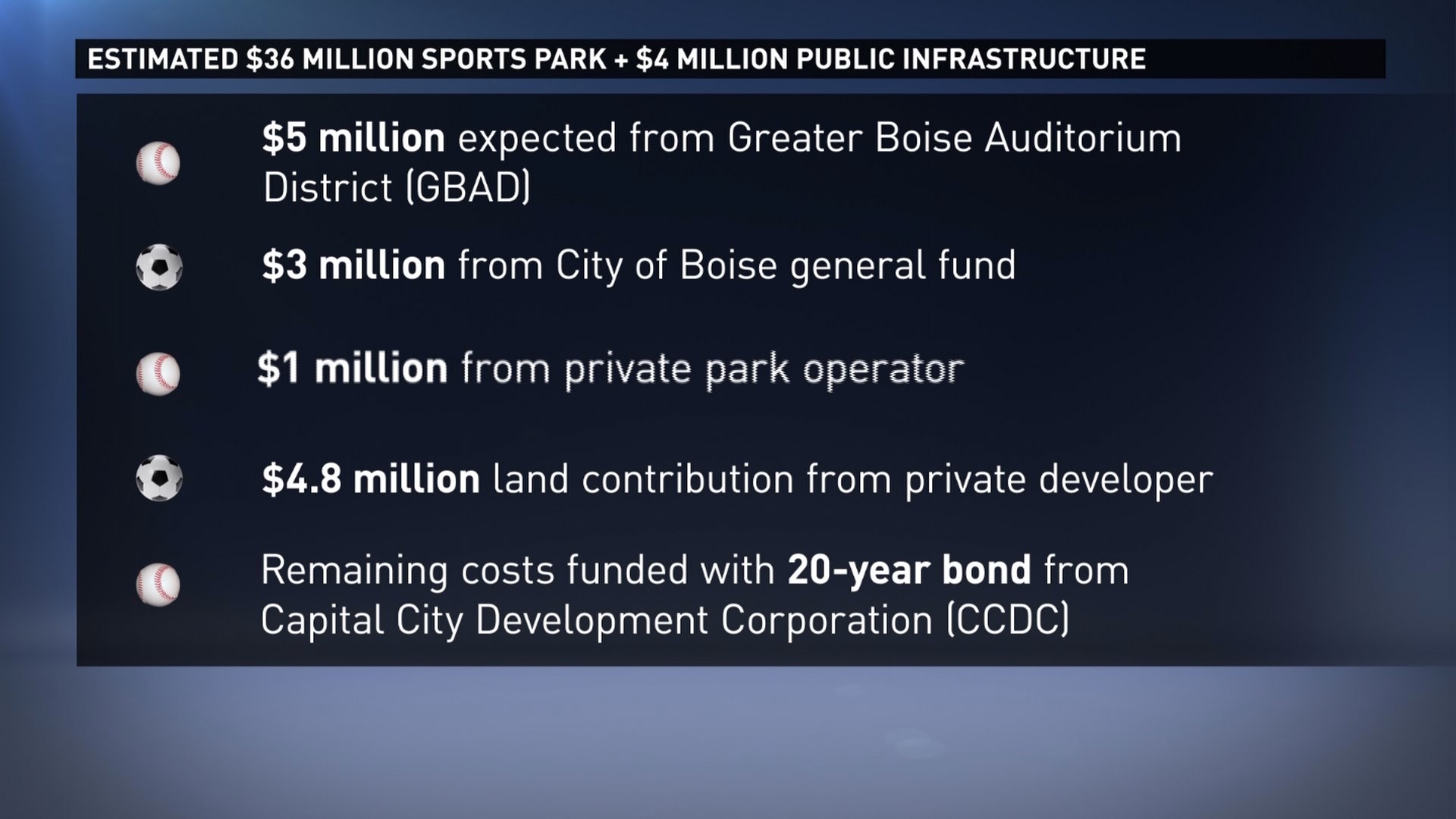BOISE -- We're peeling back more layers of the proposed Boise Sports Park, and we wanted to answer some of your concerns and questions about it.
A couple key issues we're hearing are how exactly is this going to be paid for and how are your tax dollars being used? Another: how does a new urban renewal district play a role, and how does that affect taxpayers?
The sports park would cost about $40 million to build, and it's a part of a potential $100 million mixed-use development - with the rest being housing, office space, restaurants, retail, and parking.
There are a lot of moving parts to the stadium and the funding formula is pretty complex.
"If a private developer wants to build the stadium, all the power to 'em. But right now the public shouldn't be taking the risk," Boise City Council candidate, Logan Kimball, said at the Boise Sports Park open house last week.
Taxpayers are expressing a variety of issues about the building and financing of this proposed multi-purpose downtown stadium.
"At the end of the day I think a project like this should have the vote of the people," Kimball added.
"We do a lot of different public projects around the community. They don't go to a vote," City of Boise Economic Development Director, Nic Miller, said.
So KTVB wanted to find out: how do taxpayers play a role in this stadium?
City officials say there there will be no new taxes and no increase in tax levy rates as a result of the stadium.
However, $3 million of Boise taxpayer money would go to the upfront cost of the stadium. In addition, the city and stadium operator, Agon Sports and Entertainment of Georgia, will each pay $125,000 every year in capital improvement costs, totaling $250,000 in annual capital improvement funding.
This is because the city plans to own the sports park in 20 years.
"We want to make sure that when the asset comes back to the city that it's been taken care of and it's in good shape," Miller said.
Along with the City of Boise's upfront contribution from its general fund - money that has already been set aside specifically for this - the city says the Greater Boise Auditorium District (GBAD) is expected to pay $5 million, Agon Sports will contribute $1 million, and the remaining construction costs will be funded by a 20-year bond issued by Capital City Development Corporation (CCDC).

This is where the funding gets a bit tricky. Every year, that bond would be paid for two ways: $1 million in sublease payments and $1 million in tax increment financing generated by the new private mixed-use development.
"This is money that would not exist but for this project," Miller added.
Tax increment financing would be made possible by CCDC's proposed new urban renewal district, the Shoreline District, which will include project and development areas in the Lusk Street neighborhood, along River Street from 9th Street to 16th Street, portions of underdeveloped property near the Connector, and both sides of the Boise River including along Ann Morrison. The Shoreline URD would be approximately 140 acres total.
"We've been looking at places in the community that investment has not kept up with the rate of investment of downtown and this just seems like a pretty ripe area," said Shellan Rodriguez, CCDC project manager of property development.
CCDC officials tell KTVB the Eligibility Study for the potential Shoreline Urban Renewal District was approved by their Board on Monday and will be sent to Boise City Council next week. If approved by City Council, CCDC would begin the URD planning process, which will look into the details of redevelopment and its effect on property values throughout the entire district.
"Once that goes through the process and gets approved, a baseline is set," Rodriguez said.
Once an urban renewal district is created, CCDC anticipates property values to rise.
"Any future tax increment generated after that baseline has been set would start coming back to the district," Rodriguez explained. "Not to CCDC per se but to the district. CCDC manages that money to continue to put back into the district.
"Then we'd try to help invest to continue urban renewal, continue economic development, creating more jobs, for just a 20 year period," Rodriguez added.
Local taxing districts would receive the same amount of taxes they got before, but the value above that base goes to the district, and in this case, stadium costs. That will be the case for 20 years and Rodriguez says at the end of that period, the idea is that the private investment urban renewal would help incentivize an increase in the 'end of the day' taxes.
The developer, Greenstone Properties, is currently under contract to buy 11 acres for the entire development from St. Luke's.
Meanwhile, the Central Urban Renewal District, 34 acres covering ten blocks and where the Grove Plaza is located, is sunsetting at the end of the year. So increased property taxes in that area will now go back into the local taxing districts. According to CCDC, the baseline value of all the property in the Central District Urban Renewal Area was $31 million around the year 1988. The current value of that same area is now $371 million.
City officials feel that counterbalances the money local taxing districts such as the Boise School District, Ada County, City of Boise, Ada County Highway District and more, won't be receiving if the Shoreline District is established.

